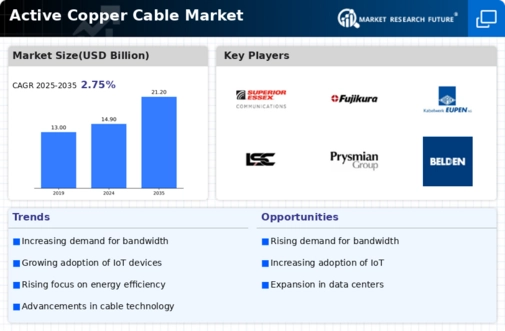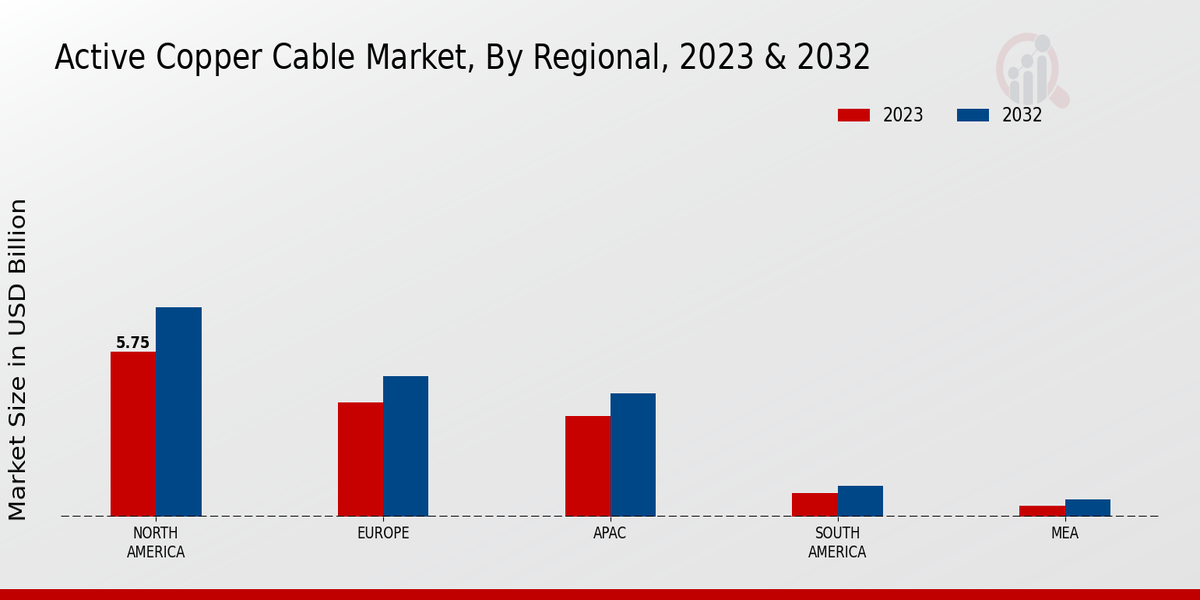Expansion of Data Centers
The expansion of data centers significantly influences the Global Active Copper Cable Market Industry. As businesses increasingly migrate to cloud-based services, the demand for data centers continues to rise. This growth necessitates the deployment of reliable cabling systems to support high-speed data transmission. By 2035, the market is expected to reach 21.2 USD Billion, indicating a robust trajectory driven by the proliferation of data centers worldwide. The need for efficient cooling and power management in these facilities further emphasizes the importance of active copper cables, which provide the necessary bandwidth and reliability for optimal performance. Consequently, this trend underscores the critical role of active copper cables in modern data infrastructure.
Market Growth Projections
The Global Active Copper Cable Market Industry is projected to experience steady growth over the next decade. With a compound annual growth rate (CAGR) of 3.27% anticipated from 2025 to 2035, the market is expected to evolve in response to technological advancements and changing consumer demands. By 2035, the market could reach 21.2 USD Billion, reflecting the increasing reliance on high-speed connectivity solutions across various sectors. This growth trajectory suggests a sustained interest in active copper cables as organizations seek to enhance their network infrastructure. The market dynamics indicate a potential for innovation and expansion, driven by the ongoing digital transformation across industries.
Rising Adoption of IoT Devices
The rising adoption of Internet of Things (IoT) devices significantly impacts the Global Active Copper Cable Market Industry. With the proliferation of smart devices across various sectors, including healthcare, manufacturing, and transportation, the demand for reliable and efficient connectivity solutions escalates. Active copper cables provide the necessary infrastructure to support the vast network of interconnected devices, ensuring seamless data transmission. This trend is particularly pronounced in smart home applications, where multiple devices require stable and high-speed connections. As the IoT ecosystem expands, the market for active copper cables is likely to witness substantial growth, driven by the need for robust networking solutions that can accommodate increasing data traffic.
Growing Demand for High-Speed Connectivity
The Global Active Copper Cable Market Industry experiences a surge in demand for high-speed connectivity solutions. With the increasing reliance on data-intensive applications, such as cloud computing and streaming services, the need for robust and efficient cabling systems becomes paramount. In 2024, the market is projected to reach 14.9 USD Billion, reflecting the growing emphasis on high-performance networking solutions. This trend is particularly evident in urban areas where smart city initiatives drive the deployment of advanced infrastructure. As organizations seek to enhance their network capabilities, active copper cables emerge as a viable solution, offering a balance between performance and cost-effectiveness.
Technological Advancements in Cable Manufacturing
Technological advancements in cable manufacturing play a crucial role in shaping the Global Active Copper Cable Market Industry. Innovations in materials and production techniques enhance the performance characteristics of active copper cables, making them more efficient and durable. For instance, the introduction of advanced insulation materials and improved shielding techniques reduces signal loss and interference, thereby increasing overall transmission quality. These advancements not only cater to the growing demands of high-speed networks but also align with sustainability goals by reducing material waste. As manufacturers continue to invest in research and development, the market is poised for growth, driven by the introduction of next-generation cabling solutions.
Regulatory Support for Telecommunications Infrastructure
Regulatory support for telecommunications infrastructure serves as a key driver for the Global Active Copper Cable Market Industry. Governments worldwide are increasingly recognizing the importance of robust communication networks for economic growth and social development. Initiatives aimed at enhancing broadband access and improving network reliability create a favorable environment for the deployment of active copper cables. Policies promoting investment in telecommunications infrastructure encourage private sector participation, leading to increased demand for high-quality cabling solutions. As regulatory frameworks evolve to support technological advancements, the active copper cable market is likely to benefit from enhanced funding and resources, facilitating the expansion of network capabilities across various regions.











